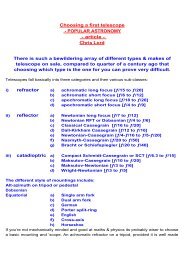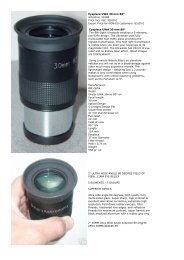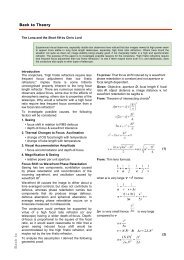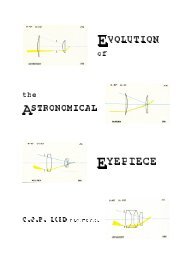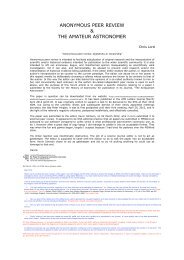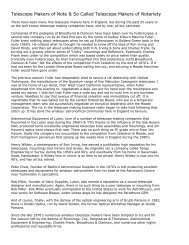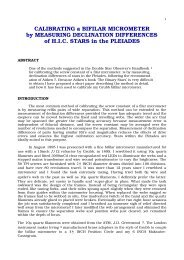SYNCHRONISED DOME ROTATION - Brayebrook Observatory
SYNCHRONISED DOME ROTATION - Brayebrook Observatory
SYNCHRONISED DOME ROTATION - Brayebrook Observatory
Create successful ePaper yourself
Turn your PDF publications into a flip-book with our unique Google optimized e-Paper software.
<strong>DOME</strong> DRIVING RATIONALES (cont.)ATM SOLUTIONSBrent Boshart has written a PC shareware pcdome.exe for the now defunct Boydcommercial domed observatory. See for an example of its use by ThomasWichmann. Brent Boshart’s shareware programme has unfortunately been pulled because Boyd Observatories Inc. has folded. However its usein the system implemented by Thomas Wichmann is ingenious as he describes:-.The basic idea is to incorporate a microcontroller into the controller box. The microcontroller "speaks" via serial lines to both the mount and the motor controllerboard. In the "regular" mode, the system simply permits to manually move the dome in clockwise or counterclockwise direction, and, of course, to stop its motion.In the "slave" mode, the dome is linked to the mount so that the dome's slit is always pointing in the direction of the telescope. For this, the mount is polled forazimuth (in the case of fork-mounted scopes), or azimuth and altitude (in the case of GEMs or other mounts); the information is used to calculate the targetdome azimuth, and the dome is moved to that target azimuth. The target calculation and movement is updated regularly so that the dome keeps up with thetelescope. For fork-mounted telescopes which are positioned so that the declination axis is the center of the dome (which means having an eccentric pier!), thedome azimuth always conincides with the scope azimuth. In GEMs, the translation between scope pointing and dome azimuth is not as simple, because therelationship between scope azimuth and dome azimuth varies with the scope altitude. The math behind this is complicated, and I finally settled (with the help ofBrent Boshart) on a more empiric approach, i.e., the program uses an input table that links scope pointing information to a certain dome azimuth.This image shows the (empiric) relationship between azimuth and altitude readoutfrom my mount and the dome azimuth required to place the dome shutter in line withthe optic axis.Linking the dome to the scope could be accomplished most elegantly through directcalculation of the dome azimuth from the telescope pointing information. This iscomplicated math. I have tried to develop the respective algorithms for a while, andhave, thus far, failed to come up with a viable algorithm for this - the problem is not somuch the translation of the hour angle/declination into dome azimuth, but the factthat the mount is not exactly in the center of the dome (see image above). Asmentioned above, Brent Boshart came up with an alternative approach that actuallyworks well, and is based on a lookup table. Scope azimuth/altitude and East/Westinformation are then used to find the two closest dome azimuth values in the lookuptable. The actual target azimuth is then determined via a simple interpolation routine.The BX-24 microcontroller is able to run through this calculation intensive routineabout once every second, so that reasonable 'slaving' accuracy can be achieved.Each iteration of this routine ends in transformation of the dome azimuth (in degrees)into the equivalent encoder counts, and a GoToTarget step, during which the IPMcard receives the current target, and initiates driving the motor towards that target.This approach, although telescope / dome specific, circumvents theprogramming complications referred to on p17.19



